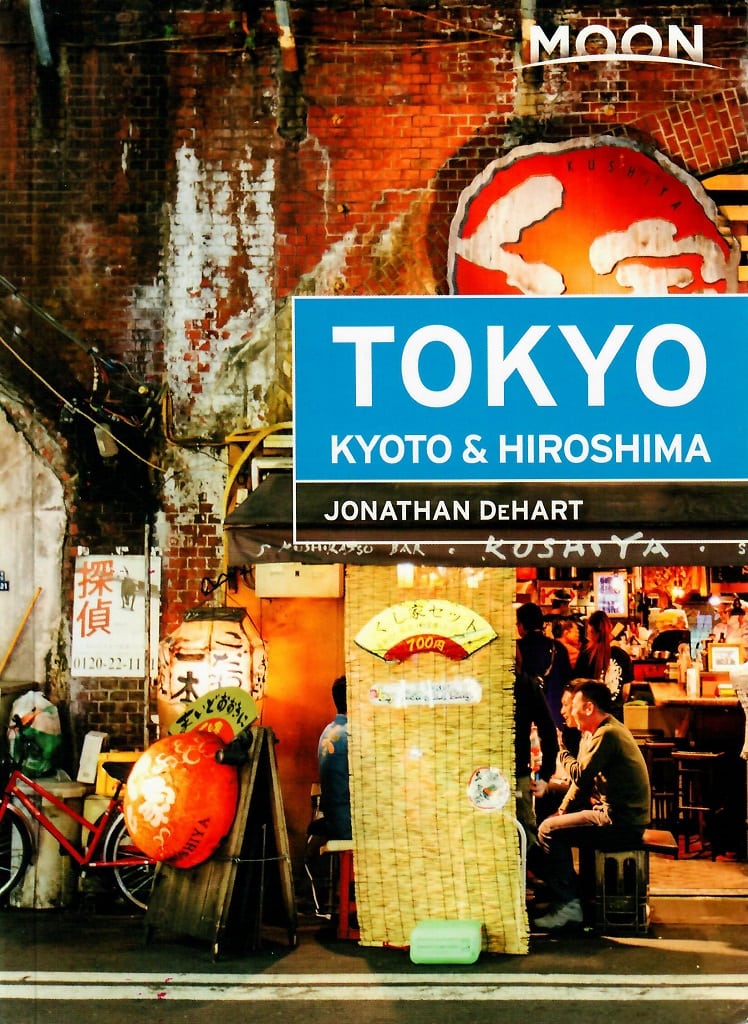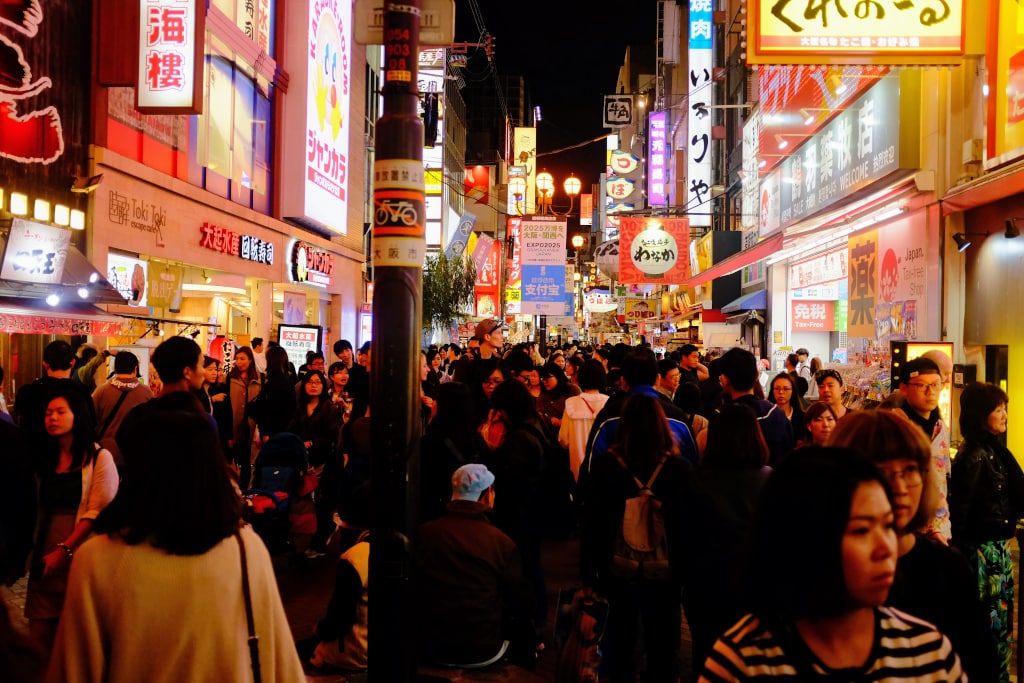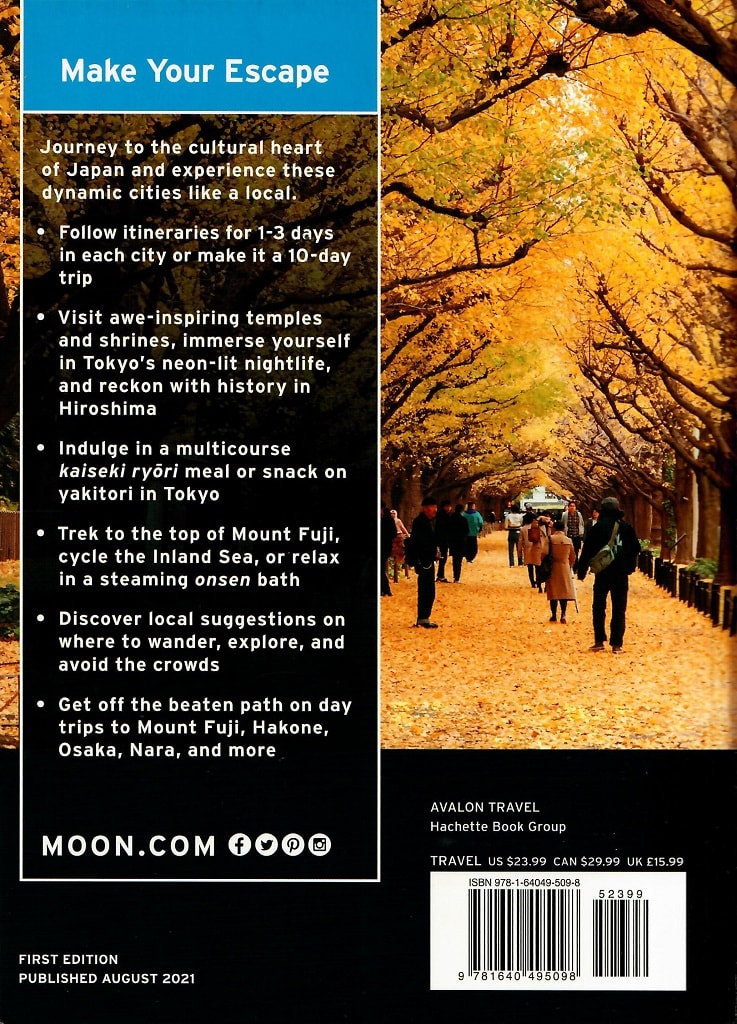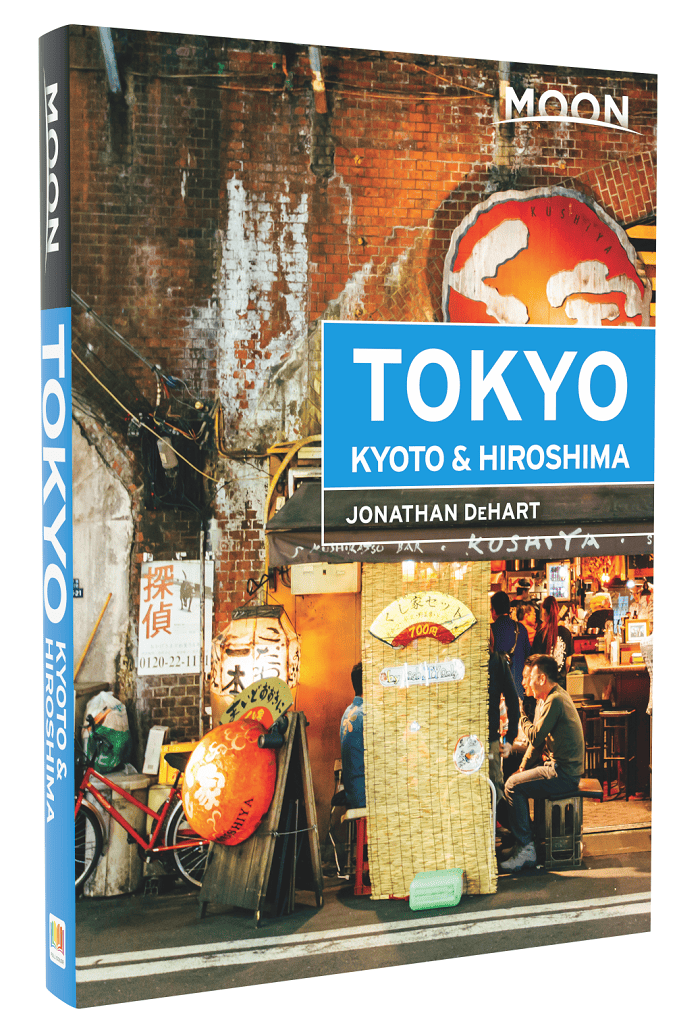First time visitors to Japan understandably focus on Tokyo, Kyoto and Hiroshima - also known as Japan's 'Golden Route'.
Although there are a good number of guide books covering the whole of Japan, there aren't (surprisingly) many dedicated to the Golden Route.
That's where Moon Travel Guides' Tokyo, Kyoto & Hiroshima comes in. Author Jonathan DeHart is a widely-published American travel writer who first came to Japan at the age of 21.
But is the book too restricted by the areas it covers, or might it actually be a must-buy?
Read on to find out...
Get my free Japan Travel Bulletin:
VIDEO: See Inside: Tokyo, Kyoto, Hiroshima (Golden Route) Moon Guide
Doing something different
You can tell straight away by just looking at the cover design of Tokyo, Kyoto and Hiroshima by Jonathan DeHart that the publisher, Moon, is trying to do something different with its Japan travel guides. Trying to appeal to a different audience than those like Rough Guides and Lonely Planet.
Tokyo, Kyoto & Hiroshima Travel Guide by Jonathan DeHart
The picture on the cover is of a small backstreet izakaya. It's going to equally attract and repel potential buyers. From a marketing perspective that's a masterstroke, because whenever you sell something you want to make sure that it primarily appeals to your target audience. And with this guide to Japan's Golden Route, Moon is doing that perfectly.
Tokyo, Kyoto & Hiroshima (Book Review)
by Rob Dyer
Featured content in the book
- Flexible itineraries for 1 to 5 days in Tokyo, Kyoto and Hiroshima that can be combined into a longer trip
- Must-see highlights and unique experiences: Stroll Kyoto's Philosopher's Path, learn about Hiroshima's history at the Peace Park, and marvel at the towering bronze Buddha in Nara's Toda-ji temple. Get a taste of Tokyo's epic nightlife, stay in a traditional ryokan, or soak up views of Mount Fuji
- The best local flavours: Indulge in a beautiful, multi-course kaiseiki, and feast on fresh sushi or savory ramen. Make your way through the largest fish market in Toyko, sample sake, and get acquainted with Japanese whiskeys at a tasting room
- Ideas for side trips from each city, including Yokohama, Nara, and Kobe
- Expert insight from American expat and longtime Tokyo local Jonathan DeHart
- Full-colour photos and detailed maps throughout
- Background information on the landscape, history, and conduct and cultural customs of each city
- Helpful resources on travelling to Japan
- Handy tools such as visa information, train travel tips, a Japanese phrasebook, and recommendations for seniors, LGBTQ+ travellers, travellers of color, families with children, and more
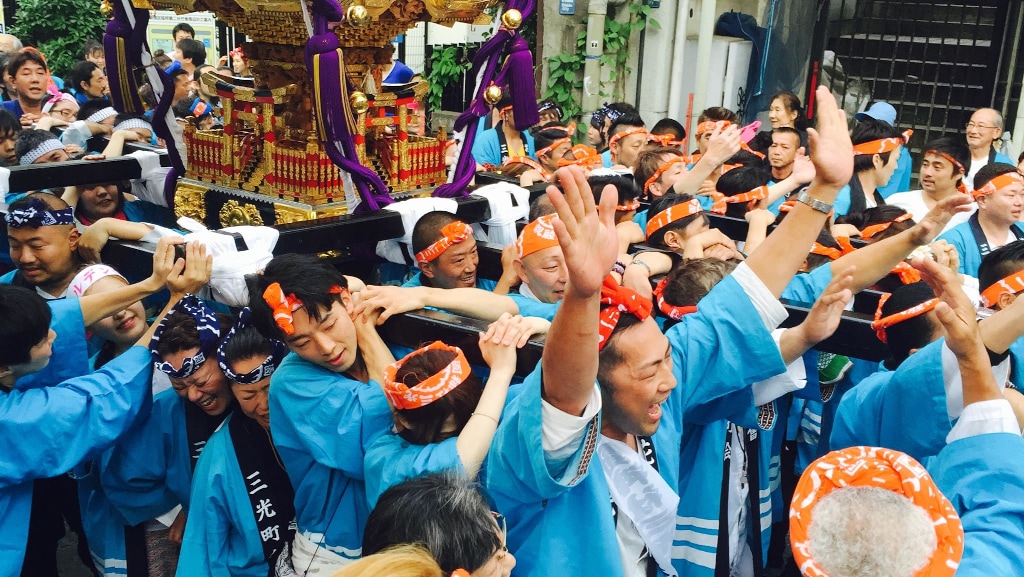
Matsuri revelers carry an omikoshi through the backstreets of Shinjuku for a summer matsuri | Photo: Jon DeHart
Focusing on Japan's Golden Route
Author of the book, Jonathan DeHart, lives in Tokyo. He's an editor and a writer, and he first came to Japan as a student studying the language, living with a host family. He's also the author of a countrywide Japan guide, also published by Moon, but this particular book is focused on what's known as Japan's Golden Route - the three or four major cities that particularly first timers coming to Japan typically want to be sure to visit.
As such, this is a really smart move.
SEE ALSO:
Our First Trip To Japan: 16-Day Itinerary & Review

Tokyo, Kyoto & Hiroshima neatly packs in all the Golden Route essentials (and a bit more besides) into less than 500 pages
What's the point in buying an 800-page guide to the entirety of Japan when, frankly, the majority of first time visitors are never going to go beyond a few core cities? It's worth saying that there's no hard definition of Japan's Golden Route. However, it always includes Tokyo and Kyoto (historically connected by the Nakasendo Way), but then usually includes Osaka or Hiroshima, pretty much interchangeably - sometimes both.
The good thing about this Moon guide is the way they've approached the production and the design. It includes many of the kinds of content benefits that the bigger, countrywide, guide books have, but it 'chunks it down' into much more manageable, bite-size sections.
SEE INSIDE: To see inside this book watch this video.
VIDEO: Japan With Jonathan DeHart (Rick Steves Travel)
Ten colour-coded sections
The pages of major sections of the book are colour coded, so when you view the book side-on you can instantly see where each section begins and ends. A nice touch. The ten sections are:
Other guides to Japan include these types of topics, but here, DeHart never 'bores' you with his entries. Other guides tend to go into almost too much detail. I know that sounds kind of crazy, but I do wonder when people are buying countrywide travel guides just how much ‘background’ they want in that guidebook.
If it were me, I’d do that research separately online or buy another book. I don't need too much extra information weighing down what is a travel focused country guide. (But maybe most people are different to me?)
About the publisher
Since 1973, Moon has been guiding travellers to unique, authentic experiences in more than 200 destinations around the world. They say they believe in "the power of travel to connect people and enrich their lives". Their authors are local experts who share Moon's commitment to independent businesses, local culture and ethical travel.
Some quick facts about the book
Not only the Golden Route
Although I said in my introduction that DeHart's book is dedicated to the Golden Route, that doesn't mean it overly restricts itself to the three popular cities in the title. Thoughtfully, the scope of the book seems to be driven by practicality. Meaning, where appropriate and useful, it also takes in neighbouring locations and sights along the route.
For example, there's 51 detailed pages about the Kansai area (with sections given over to Osaka, Nara, Kobe and Himeji). Kansai accounts for a large part of Western Honshu (Japan's main island), is close to Kyoto and sits roughly midway between Tokyo in the north and Hiroshima in the south. It makes complete sense to include it. The book would be less valuable had it been excluded.
The same goes for the locations between Tokyo and Kyoto.
This section includes itinerary ideas taking in Yokohama, Kamakura, Hakone, Mount Fuji and the Fuji Five Lakes. Likewise, the region between Kansai and Hiroshima, which has itinerary ideas that include Okayama, Kurashiki, 'The Art Islands' (in the Seto Inland Sea), Onomichi and the Shimanami Kaido. (See JJ Walsh's Hiroshima City Guide for more on these locations.)
SEE ALSO: How To Spend A Week In Kansai (And Not Visit Kyoto)
Clearly structured content, zooming in on the detail
The contents of the book are well structured and then broken down.
At the beginning you've got a countrywide map, it then zooms into the scope of the book. So you have a map spanning two pages with Hiroshima on the left, Kyoto in the middle and Tokyo to the right in the north. Each of the three main cities have a dedicated section with similarly designed (but not exactly the same) sub-sections.

Soba in Kyoto | Photo: Jon DeHart
These include information on itinerary ideas, sites, entertainment and events, food, shopping, bars, etc. All the usual things you might expect to find. There's also details on accommodation, services, how to get there, how to get around, and so on.
SEE ALSO: 9 Best Budget Hotels in Tokyo
Making it easy to build itineraries
In the section headed Between Tokyo and Kyoto, again it starts with some itinerary ideas, which is really handy. A lot of people, especially first timers, find these kind of suggested itineraries for an area particularly helpful. They often want to be based in a city but also want to reach out to surrounding areas, and suggested itineraries make that process so much easier. This section includes places such as Yokohama, Kamakura, Hakone, Mount Fuji and the Fuji Five Lakes area.
For the section on Kansai, again it begins with some itinerary ideas such as A Weekend in Osaka and Nara and Himeji and Kobe in One Day. If you're going to be in the Kansai region, the cities of Osaka, Nara and Kobe (one of my personal favourites) and Himeji are all worth seeing in my view.

Between Kansai and Hiroshima is the Shimanami Kaido cycle route taking in the islands of the the Seto Inland Sea
For the section Between Kansai and Hiroshima, it also starts with itinerary ideas, but includes smaller cities and towns such as Okayama, Kuroshiki (which is a lovely spot a lot of people skip over without realising), the ‘art islands’ in the Seto Inland Sea area, Onomichi and the Shimanami Kaido - the cycling route spanning several islands in the Shikoku region.
The section on Hiroshima and Miyajima island has itinerary ideas and sections focusing on Hiroshima, Miyajima and Iwakuni.
SEE ALSO: Hiroshima City Guide
The 'essentials'
The Essentials section at the back of the book contains just what you would expect. Transportation, what it calls ‘Visas and Officialdom’ (which I like as a label!), festivals and events, food and drink, accommodation, etc. But it also goes into things like Conduct and Customs, which is good to see. I have a blog post (Top 7 Etiquette Tips for Travel in Japan) about etiquette in Japan. A quite important consideration when visiting Japan actually.

Kyoto's highlights are conveniently grouped into the city's main districts, making it easy to plan your days
When I’m travelling overseas my personal goal is always to try and blend it as much as possible. I don't want to be rude or offensive even if it's by mistake, through ignorance. So it's always good in my view to do some research in advance of when you travel on the local customs and culture. So that you don't (even mistakenly) do anything rude or offensive to the locals.
The Essentials section also includes the key information regarding health and safety, basic travel advice and practical details, money, using public transportation, car rental, etc. Then, in the Resources section at the back, it has a glossary of terms which is quite handy, and a Japanese ‘phrase book’ section which is pretty good. It's always good to learn at least a few basic phrases when you're travelling in any country.
If you're still a little apprehensive about travelling in Japan when you don't speak (or read) Japanese you might find this post helpful. I also have a concise ebook entitled How To Travel in Japan Without Speaking Japanese if you'd like more advice and tips on the subject.
DeHart's guide ends with a brief Suggested Reading section, and information on Internet Resources and Apps.
SEE ALSO: Kyoto City Guide
The index - is it any good?
Weak, sometimes even non-existent indexes, are a bit of a bugbear of mine in travel guides. What, frankly, is the point of an 800-page guidebook if it doesn't properly index the key content? Rough Guides do this, and it really irritates me. There's some excellent content in the Rough Guide to Japan, yet some fairly big name places mentioned just don't feature in the index, which is crazy.

Festival musicians | Photo: Jon DeHart
The good thing with this Moon guide is they do have an index, so that's a tick to start with!
Considering the book is focused on just the Golden Route, it's got just about the right amount of detail that you would want, both from the guide itself and the index. Obviously, all the major cities are indexed, but then it includes some of the specific smaller places, attractions and cultural points of interest.
I wouldn't say it's got a lot of detail, but it feels like it's got all the essential stuff - which is a hard balance to pull off. I take my hat off to DeHart and the publishers for striking that balance and producing what is a really useful practical guide that is still very distinctive and has a very strong personal perspective and voice.
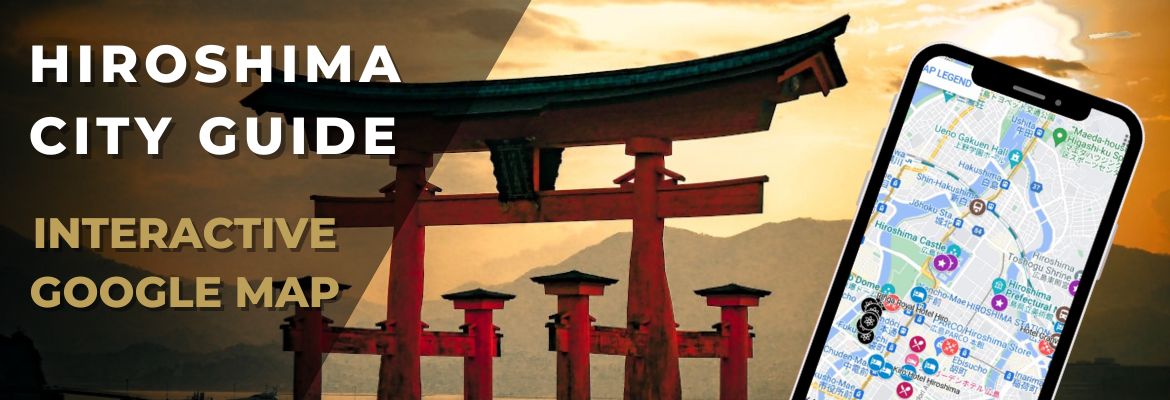
A list of all the maps
There’s also a list of all the maps that are in the book, which is very helpful. I should say, the maps themselves are not super detailed, they're fairly basic for the most part. However, if you're looking at a particular area, such as greater Tokyo, it will give you the key landmarks. But what is quite effective in the major destinations and biggest cities are its often more detailed maps. To give you your bearings, it has region map, then it zooms in to a city view, and then zooms into a district within the city.
It’s almost like you're using Google Maps online.
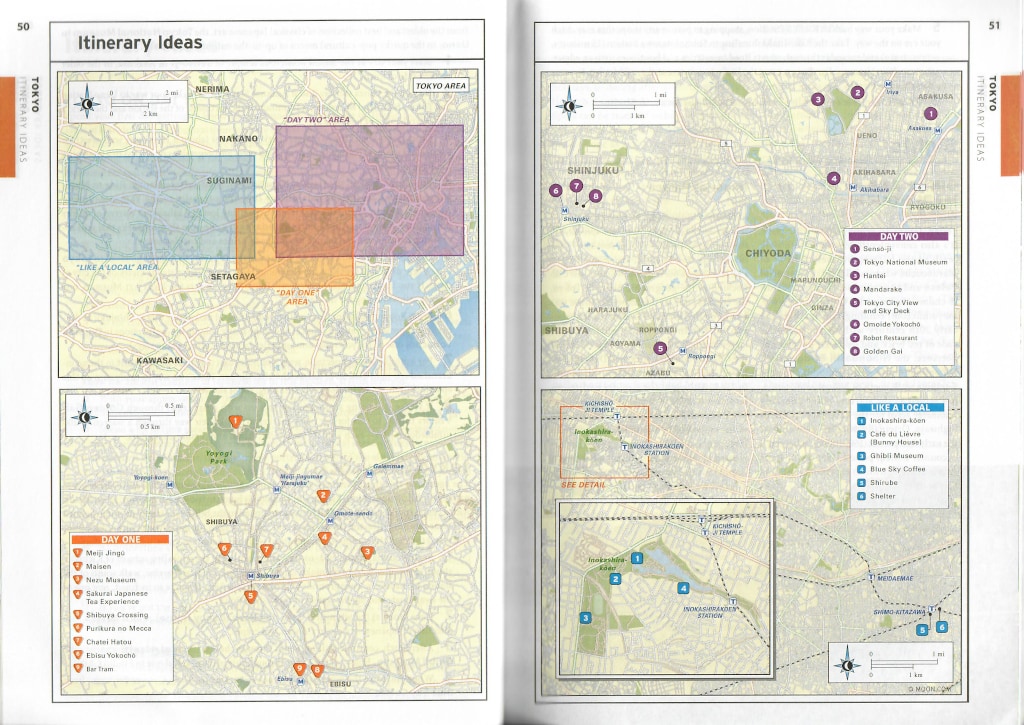
The book features some of the best-organised and presented content of any Japan travel guide I've read
The book pretty much replicates how you would do your research online. It starts with that ‘big picture’ view and then zooms in.
This is useful because it gives you an easy way to build your own itineraries, as you can see the areas surrounding a given city. For example, when looking at Tokyo, you can see the kind of distance that it is from Yokohama. You have neighbouring cities like Kawasaki and Kamakura, and once you zoom in, the book then gives you details on key sites you might want to see and experiences specific to those cities.
It's a nicely considered design and one of the best examples of how to apply use of maps in a general travel guide like this.
Plenty of photos, taken by the author himself
As you’d expect, it's got plenty of photographs, a good number of which were actually taken by DeHart himself (a few of which are reproduced here in this review), rather than relying exclusively on sometimes generic-looking stock photo library images. Every page is in colour. Both elements unlike the big-name Japan guides. The paper quality is actually pretty good. I'm not sure what the weight is, but it's thicker than the most recent Rough Guide I have.

Women in yukata in Ginza | Photo: Jon DeHart
You can tell that Jonathan DeHart really knows his stuff.
There's loads of personal recommendations along the way. Cafes, little bars, restaurants, ryokan, hotels, all these kinds of practical aspects of travel that you would want from a guide. But you really do get a sense that DeHart is drawing on decades of experience of living in and travelling through Japan to provide you with some of these personal recommendations and insights.
This is quite key, I think, to the success of the book.
A single author's voice and perspective
The Rough Guides and the Lonely Planets of this world are written by multiple authors. And when you read those guides, you can often tell that. Obviously, they try to blend the different styles of different authors, but there’s almost a sense of inconsistency or 'unevenness' when you're reading those larger guides. Moon’s Tokyo, Kyoto and Hiroshima, as a guide to Japan's Golden Route, doesn't suffer from this.
Author Biography: Jon DeHart
Jonathan DeHart is a Tokyo-based journalist and editor who first came to Japan at the impressionable age of 21 to study the language.
He writes primarily about culture and social trends in Asia. With more than 500 published articles, his work has been selected for various "best of" lists by The Washington Post, The Atlantic, The Huffington Post, Foreign Policy and Real Clear World.
He previously worked for both print and online media in Shanghai, China.

Author Jonathan DeHart | Photo: David Freeman
Unlike all the other Japan travel guides that I've read, precisely because it has a consistent voice and perspective, thanks to DeHart, Tokyo, Kyoto & Hiroshima is written more in a prose, almost narrative, style. It has a wonderfully conversational tone to it, like you're sitting with a knowlegable friend who is casually sharing their insights and expertise with you.
I haven't yet read Moon's full Japan guide, but it is also written exclusively by Jonathan DeHart. It would be very interesting to see if that book is as successful as this book due to DeHart's single voice. I'll look forward to picking up a copy and, when I do, I'll be sure to review it for you.
Conclusion: Tokyo, Kyoto & Hiroshima - should you buy it?
I have to say, off the top of my head, I haven't noticed if the bigger publishers have published guides exclusively to Japan’s Golden Route. If they have, I've not spotted them but perhaps they're out there.
If you’re a first time traveller to Japan, and you want to travel independently but you want to include the major cities like Tokyo, Kyoto, Hiroshima and several of the key destinations in between, then honestly I think you'd be hard pushed to improve upon this Moon's Tokyo, Kyoto & Hiroshima guide.
I wouldn't hesitate to recommend this guide. And it's not just first-time visitors to Japan that can get value from it either. I think it's an excellent book and one that's worth picking up.
Buy Tokyo, Kyoto & Hiroshima by Jonathan DeHart

About the Author
A writer and publisher from England, Rob has been exploring Japan’s islands since 2000. He specialises in travelling off the beaten track, whether on remote atolls or in the hidden streets of major cities. He’s the founder of TheRealJapan.com.
Resources
VIDEO: See Inside: Tokyo, Kyoto & Hiroshima
Buy Tokyo, Kyoto & Hiroshima on Amazon
Moon Website
Moon.com
Author's Website
Jonathandehart.com
Further Reading
5 Best Hiroshima Coffee Shops for Java Lovers
Hiking and Trekking The Japan Alps and Mount Fuji (Book Review)
Hiroshima City Guide Google Map
How To Choose The Best Japan Travel Guidebook
How to Travel in Japan Without Speaking Japanese eBook
Japanese Inns and Hot Springs: A Guide to Ryokan and Onsen (Book Review)
Planning A Trip To Japan eBook
Strolling Zōshigaya – Tokyo Off The Beaten Path
More Itinerary Ideas
2 Week Tour of Chugoku: Easy 16 Day Itinerary
5 Days In Kyushu: An Unforgettable Itinerary
Accessible Japan Sightseeing Tips (How We Honeymooned in Japan)
Our First Trip To Japan: 16-Day Itinerary & Review
Valuable Insights From my 17th Trip To Japan (Includes 28 Day Itinerary)
Enjoyed this article? Why not share this image? ↓
Have you read Tokyo, Kyoto & Hiroshima? Or have any questions about the book? If so, I'd love to hear from you - please leave a comment below...

